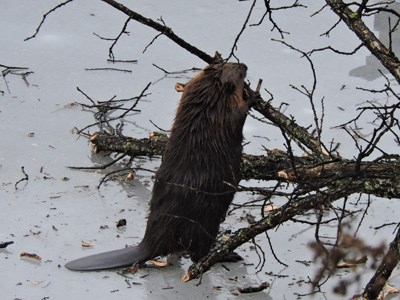
NPS Introduction The American Beaver has influenced this region for hundreds of years. In the mid-1700s, French-Canadian voyageurs traversed these waters trading their European goods for beaver furs trapped by the Ojibwe Indians. Today, beavers are abundant throughout the park and continue to shape the landscape. Beaver habitat can be identified by a lodge, dam, or beaver-chewed branches. Beavers, also known as nature's engineers, have the uncanny ability to alter a habitat to meet their needs. They will dam up rivers and streams, flooding the surrounding forests to create a suitable pond to raise their young. As the pond fills up, they begin construction on an intricate lodge made of sticks and mud. The only entrance into the lodge is underwater which deters predators. The parks landscape is decorated with hundreds of beaver ponds. These ponds also provide excellent habitat for moose, water birds, and an array of aquatic species. Beavers also build lodges along the banks of the large lakes, which eliminates the need to create a pond. Where can you see beavers? Beavers maybe seen swimming along the shorelines of the park's lakes and are occasionally viewed cutting down trees along the water's edge. Active beaver lodges are scattered throughout the park and are identified by peeled logs laying on top of a lodge and a fresh coating of mud. A hike on the Black Bay Beaver Pond Trail, Locator Lake Trail, or Cruiser Lake Trail will lead you to beaver ponds where you may see this large rodent busy at work. Population The abundance of water and forest resources in Voyageurs makes the park an ideal habitat for beavers. The beaver population has always remained at healthy numbers. The last complete census of beavers in the park occurred in 2000 and suggests a population of approximately 3,000 beavers. This estimate is based on the number of active lodges in the park. Status Beavers are an adaptable species capable of rapidly reproducing and populating an area with available habitat. Hence, Minnesota currently boasts a healthy population of beavers, though they were nearly extirpated from Minnesota by 1900 due to over-harvest. Trapping is legal throughout Minnesota but not within the boundaries of Voyageurs. Because ear-tagged beavers from the park occasionally spend time on state or private lands, some of these beavers have been harvested legally on adjacent properties. Trappers are still encouraged to report any ear-tagged beavers to the park to provide information on beaver dispersal and age. 
NPS Characteristics Beavers have distinct large, orange incisors which aid in cutting down trees. Their scaly, paddle-like tail serves five purposes: a rudder when swimming, a kick-stand to prop themselves up, a warning to intruders when slapped against the water, fat storage and sweat glands. A brown, two layered fur coat helps keep the beaver warm and dry. Adult beavers weigh 35-55 lbs. Breeding Beavers reach breeding age at 2 years old. They mate during the winter months and give birth in late spring to a litter of 7-9 kits. The kits can swim as early as one week old, but will remain close to the lodge during their first few months of life. How can you help beavers?
The role beavers play in Voyageurs' ecosystem is crucial to the survival of other species. Therefore it is important for researchers to understand the population status and distribution of beavers in the park. Each fall, beavers are captured at select lodges and ear tagged. The tags allow biologists to identify individual beavers when recaptured in the following years and collect important data on each animal. Age and dispersal are key pieces of data that can be determined by recapturing an ear-tagged beaver. Other information, like number of kits captured each season, can indicate if the population is increasing, decreasing, or constant. Beavers and the Future The outlook for beavers in Voyageurs is positive. A good supply of aspen and birch trees for food, miles of shoreline, and numerous ponds for building lodges will provide beavers with the staple items they need for survival. Researchers will continue to monitor the health and effect of predation on beavers, but expect the species will continue to thrive into the future.
For more wildlife exploration |
Last updated: April 18, 2018
